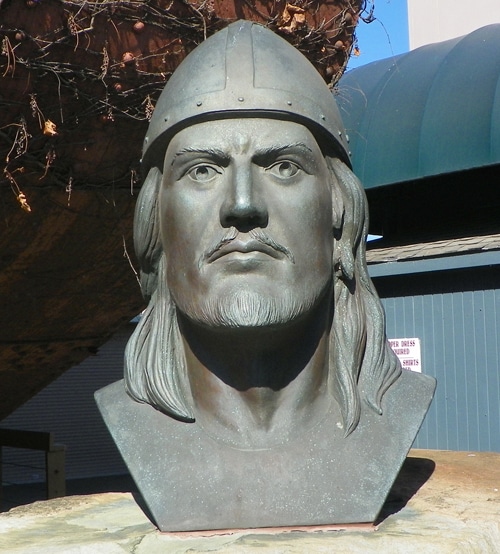Many believe that Christopher Columbus was the first European to lay eyes on a new continent, but almost 500 years prior to Christopher Columbus's epic journey, a Norseman named Leif Ericson set foot on North America.
The Vikings of Scandinavia were the first to discover and understand that there was a new continent to the west of them.
While Christopher Columbus did discover the West Indies, he died believing he had reached Asia.
Eventually, Leif Ericson did receive credit for his discovery when President Calvin Coolidge said it was him and not Columbus that made the discovery of the Americas.
Jump to:
Leif Ericson Facts: Early Life and Religious Beliefs
Leif Ericson was born to Erik the Red and his wife Þjóðhildur and was the grandson of Thorvaldr Ásvaldsson. He was probably born in Iceland but spent time with his grandfather in Greenland. Leif seemed to be raised for many years by his grandfather and referred to his actual father as a "foster father."
Around the year 999, Leif arrived in Norway after being blown off course and became a hirdman for King Olaf Tryggvason. During this time, Leif converted to Christianity and was given the mission to introduce Christianity to Greenland.

On his way to Greenland, Leif was blown off course and ended up landing in North America. This place would come to be known as Vinland. He continued with his mission to introduce the religion of Christianity to Greenland and succeeded.
Leif Ericson Facts: Vinland
Leif was not the first European to see new lands to the west. There was a story that trade merchant Bjarni Herjólfsson had also been blown off course, and while he never made landfall, he had seen a different land and had spoken about his sightings.
Bjarni would have been the first European to see a New World, but he never made landfall. According to Norse writings about Leif Ericson, during his voyage back to Greenland, he picked up two men who had shipwrecked. These two men would have been the first Europeans to make landfall in the New World.
Leif then approached Bjarni, purchased his ship, gathered a crew of thirty-five men, and mounted an expedition towards the land Bjarni had described. His father, Erik, was set to join him but dropped out after he fell from his horse on his way to set sail, an incident he interpreted as a bad omen.
Leif followed Bjarni's route in reverse and landed first in a rocky and desolate place he named Helluland (Flat-Rock Land; possibly Baffin Island). After venturing further by sea, he landed the second time in a forested place he named Markland (Forest Land; possibly Labrador).
Finally, after two more days at sea, he landed in a verdant area with a mild climate and plentiful supplies of salmon. As winter approached, he decided to encamp there and broke his party into two groups - one to remain at camp and the other to explore the country.
During one of these explorations, Tyrker discovered that the land was full of vines and grapes. Leif, therefore, named the land Vinland. There, he and his crew built a small settlement, which was called Leifsbúðir (Leif's Booths) by later visitors from Greenland. After having wintered over in Vinland, Leif returned to Greenland in the spring with a cargo of grapes and timber.
On the return voyage, he rescued an Icelandic castaway and his crew, earning him the nickname "Leif the Lucky."
Leif Ericson Facts: Personal Life and Death
Leif was described as a wise, considerate, and strong man of striking appearance. During his stay in the Hebrides, he fell in love with a noblewoman, Thorgunna, who gave birth to their son, Thorgils. Thorgils was later sent to Leif in Greenland, but he did not become popular.
After Leif's first trip to Vinland, he returned to the family estate of Brattahlíð in Greenland and started preaching Christianity to the Greenlanders. His father, Erik, reacted coldly to the suggestion that he should abandon his religion, while his mother, Thjóðhildr, quickly became a Christian and built a church called Thjóðhild's Church.
Leif is last mentioned alive in 1019, and by 1025, he had passed on his chieftaincy of Eiríksfjǫrðr to another son, Thorkell. Nothing is mentioned about his death in the sagas. He probably died in Greenland sometime between these dates. Nothing further is known about his family beyond the succession of Thorkell as chieftain.
